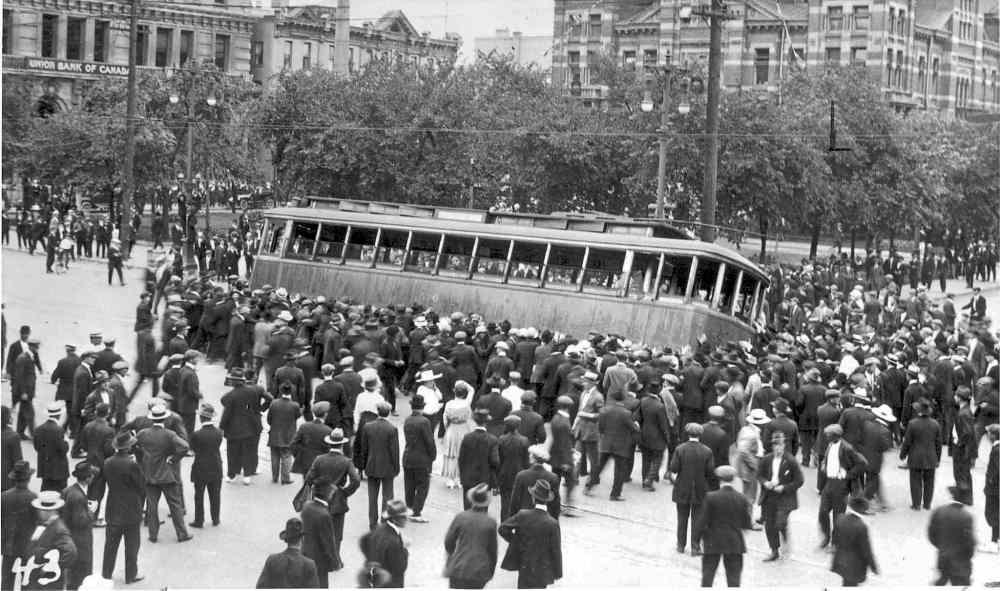General strike lessons learned
Advertisement
Read this article for free:
or
Already have an account? Log in here »
To continue reading, please subscribe:
Monthly Digital Subscription
$19 $0 for the first 4 weeks*
- Enjoy unlimited reading on winnipegfreepress.com
- Read the E-Edition, our digital replica newspaper
- Access News Break, our award-winning app
- Play interactive puzzles
*No charge for 4 weeks then billed as $19 every four weeks (new subscribers and qualified returning subscribers only). Cancel anytime.
Read unlimited articles for free today:
or
Already have an account? Log in here »
Hey there, time traveller!
This article was published 25/06/2015 (3226 days ago), so information in it may no longer be current.
On this date, 96 years ago, the most dramatic event in Winnipeg’s history ended. Or, did it?
On June 26, 1919, the Winnipeg General Strike was called off. After the disastrous Bloody Saturday June 21, a bargaining stalemate with a number of unions, over 30,000 workers on strike for six weeks and recently returned soldiers having nothing to show for their protests, the strike ended. Because there were no formal gains out of the strike, some call it a failure.
With the benefit of hindsight, however, we can say the strike formally ended, but its influence on Winnipeg, Manitoba and all of Canada continues into today’s social and political relations. The social and economic conditions that provoked the strike also provoked social reforms and benefits we value but take for granted today.

Shortly after the strike’s dramatic efforts to get employers to recognize collective bargaining and a living wage, then-premier Norris agreed to call a Royal Commission into the labour and living conditions that led to the Winnipeg General Strike. The Conservative government was defeated federally in 1921, and the Liberals came to power with a promise to reform labour and social conditions.
In the 1919 civic elections, labour increased its representation from five to seven. In the provincial election the next year, 11 labour representatives were elected to the legislature, three of whom were still in jail. In 1921, J.S. Woodsworth, a key strike leader, was elected to Parliament while one compatriot, John Gordon, was elected mayor in 1935.
The strike set in motion political changes that led to the formation of the Co-operative Commonwealth Federation in 1932 that became the New Democratic Party in 1961. The first NDP government in Manitoba was elected in 1969.
We now have legislation to protect union rights, standardized health and safety conditions, social and seniors housing, improved social welfare, pharmacare, home care and the second public auto-insurance program in Canada.
Poverty and the living conditions leading to the strike also led to the Community Welfare Council in 1919, precursor to the Social Planning Council of Winnipeg. The SPCW, together with community leaders, developed the first Indian and Metis Friendship Centre in Canada, Winnipeg’s three women’s resource centres, the Elmwood Community Resource Centre and many other health and educational programs that have enhanced the lives of thousands of Winnipeggers.
In 1921, William Alloway gave $100,000 to start the Winnipeg Foundation, the first community foundation in Canada. The foundation, the SPCW and others worked to create the Community Chest, which transformed into United Way Winnipeg in 1965.
Even without the resources or population base of other provinces, Manitobans regularly rank among the most generous when it comes to supporting each other. It may just be Prairie pragmatism, but we do seem to accept the notion, at least, that we all benefit when we all help.
Unfortunately, though, the social and economic divide that provoked the Winnipeg General Strike is still too prevalent. There is still a north/south split. People from the south side of Winnipeg fear being in the North End, and some North Enders have never been south of the Assiniboine unless to work.
Income inequality remains a barrier, especially for indigenous peoples and newcomers. Poverty is the major determinant to full social inclusion.
History is valuable. When we choose to remember it, history positively informs our present and future. It is unfortunate Victoria Park, where the strikers met daily to co-ordinate action, was destroyed by the city in 1922. Today there are only a few plaques scattered around the city and a small empty plot called Victoria Parkette to commemorate the Winnipeg General Strike. And we will just have to wait and see what the Canadian Museum of History in Ottawa comes back with now they have dismantled their original 1919 exhibit.
Although we can remember the strike in 1919 as history long past, we can see its impact on today. Moving ahead, we can use its lessons as an impetus to address the ongoing issue of social inclusion. June 21, 1919, was a tragic day, but now we can celebrate National Aboriginal Day on that date. We can acknowledge Premier Greg Selinger’s apology for the Sixties Scoop. We can also demand action on the 94 recommendations from the Truth and Reconciliation Commission. It is time once again to demonstrate Manitobans know what needs to be done and how to get it done.
Kate Kehler is the executive director of the Social Planning Council of Winnipeg.


